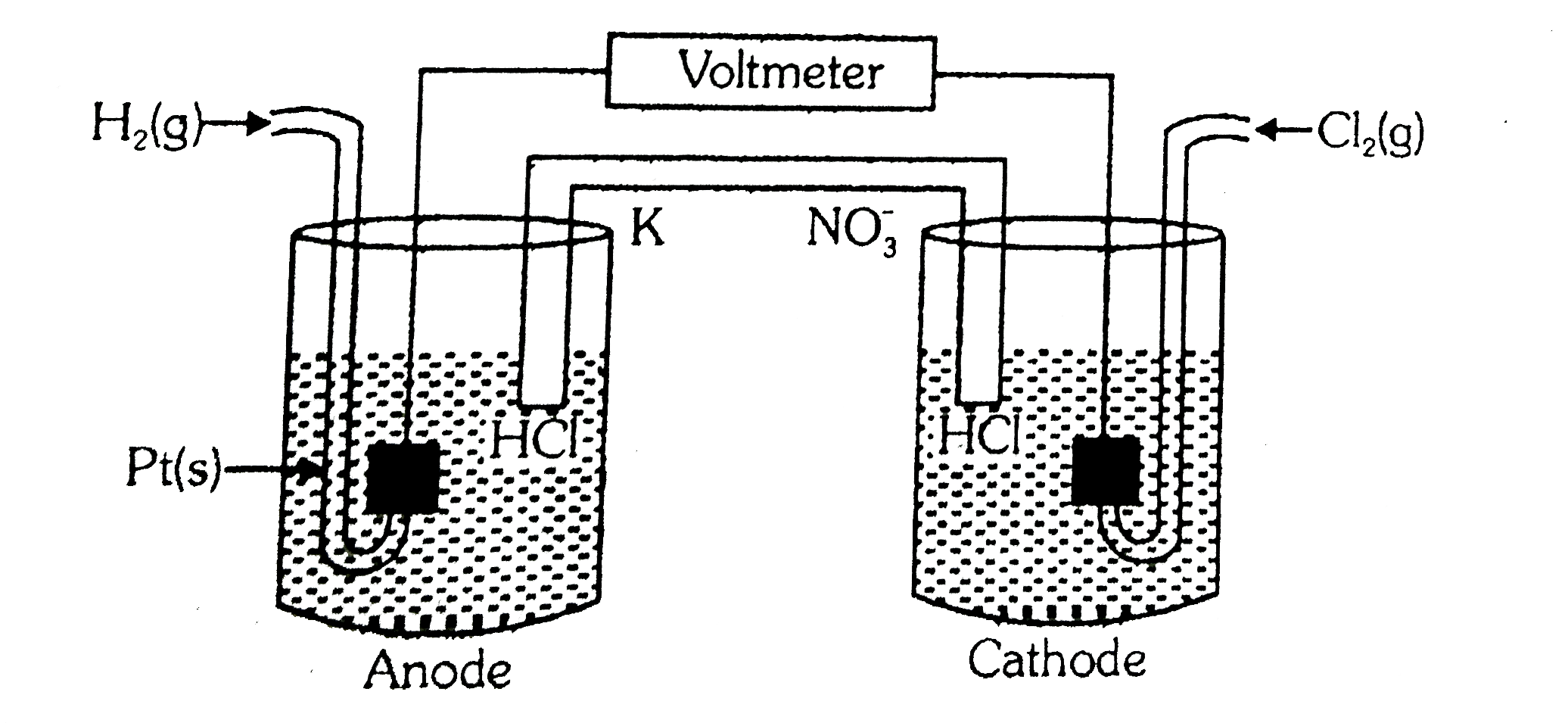The cell consists of three compartments separated by porous barriers. The first contains a cobalt electrode in 5.00 L of 0.100 M cobalt (II) nitrate, the second contains 5.00 L of 0.100M AgNO3. Assuming that the current within the cell is carried equally by the positive and negative ions, tabulate the concentrations of ions of each type in each compartment of the cell after the passage of 0.100 mole electrons.
given Co2++2e−→Co E0=−0.28V
Ag++e−→Ag E0=0.80V
Spontaneous reaction is: 2Ag++Co2++2Ag 1.08V
To solve the problem, we need to determine the concentrations of ions in each compartment after the passage of 0.100 moles of electrons. We will analyze the reactions occurring at the cobalt and silver electrodes and then calculate the resulting concentrations of ions.
1. Identify the Reactions:
- At the cobalt electrode:
Co2++2e−→Co(E0=−0.28V)
- At the silver electrode:
Ag++e−→Ag(E0=0.80V)
2. Determine the Amount of Electrons Transferred:
- Given that 0.100 moles of electrons are passed through the cell, we can determine how many moles of each ion will be reduced or oxidized.
- The cobalt reaction consumes 2 moles of electrons for every mole of Co deposited. Therefore, the amount of Co deposited is:
Moles of Co=0.100moles of electrons2=0.050moles
3. Calculate the Change in Concentration of Co²⁺:
- The initial concentration of Co²⁺ is 0.100 M in 5.00 L:
Initial moles of Co2+=0.100M×5.00L=0.500moles
- After depositing 0.050 moles of Co, the remaining moles of Co²⁺ will be:
Remaining moles of Co2+=0.500−0.050=0.450moles
- The new concentration of Co²⁺ is:
New concentration of Co2+=0.450moles5.00L=0.090M
4. Calculate the Change in Concentration of Ag⁺:
- The silver reaction consumes 1 mole of electrons for every mole of Ag deposited. Therefore, the amount of Ag deposited is:
Moles of Ag=0.100moles of electrons
- The initial concentration of Ag⁺ is also 0.100 M in 5.00 L:
Initial moles of Ag+=0.100M×5.00L=0.500moles
- After depositing 0.100 moles of Ag, the remaining moles of Ag⁺ will be:
Remaining moles of Ag+=0.500−0.100=0.400moles
- The new concentration of Ag⁺ is:
New concentration of Ag+=0.400moles5.00L=0.080M
5. Concentration of Other Ions:
- The concentration of NO₃⁻ ions remains unchanged at 0.100 M in both compartments since they are spectator ions and do not participate in the redox reactions.
Final Concentrations Table:
| Compartment | Ion Type | Concentration (M) |
|-------------|---------------|--------------------|
| 1 | Co²⁺ | 0.090 |
| 1 | NO₃⁻ | 0.100 |
| 2 | Ag⁺ | 0.080 |
| 2 | NO₃⁻ | 0.100 |
- At the cobalt electrode:
Co2++2e−→Co(E0=−0.28V)
- At the silver electrode:
Ag++e−→Ag(E0=0.80V)
- Given that 0.100 moles of electrons are passed through the cell, we can determine how many moles of each ion will be reduced or oxidized.
- The cobalt reaction consumes 2 moles of electrons for every mole of Co deposited. Therefore, the amount of Co deposited is:
Moles of Co=0.100moles of electrons2=0.050moles
- The initial concentration of Co²⁺ is 0.100 M in 5.00 L:
Initial moles of Co2+=0.100M×5.00L=0.500moles
- After depositing 0.050 moles of Co, the remaining moles of Co²⁺ will be:
Remaining moles of Co2+=0.500−0.050=0.450moles
- The new concentration of Co²⁺ is:
New concentration of Co2+=0.450moles5.00L=0.090M
- The silver reaction consumes 1 mole of electrons for every mole of Ag deposited. Therefore, the amount of Ag deposited is:
Moles of Ag=0.100moles of electrons
- The initial concentration of Ag⁺ is also 0.100 M in 5.00 L:
Initial moles of Ag+=0.100M×5.00L=0.500moles
- After depositing 0.100 moles of Ag, the remaining moles of Ag⁺ will be:
Remaining moles of Ag+=0.500−0.100=0.400moles
- The new concentration of Ag⁺ is:
New concentration of Ag+=0.400moles5.00L=0.080M
- The concentration of NO₃⁻ ions remains unchanged at 0.100 M in both compartments since they are spectator ions and do not participate in the redox reactions.
|-------------|---------------|--------------------|
| 1 | Co²⁺ | 0.090 |
| 1 | NO₃⁻ | 0.100 |
| 2 | Ag⁺ | 0.080 |
| 2 | NO₃⁻ | 0.100 |
Topper's Solved these Questions
- BOOK - RESONANCE ENGLISHCHAPTER - ELECTROCHEMISRYEXERCISE - Miscellaneous Solved Problems9videos
ELECTROCHEMISRY
- BOOK - RESONANCE ENGLISHCHAPTER - ELECTROCHEMISRYEXERCISE - Board Level Exercise20videos
ELECTROCHEMISRY
- BOOK - RESONANCE ENGLISHCHAPTER - ELECTRO CHEMISTRYEXERCISE - PHYSICAL CHEMITRY (ELECTROCHEMISTRY)53videos
ELECTRO CHEMISTRY
- BOOK - RESONANCE ENGLISHCHAPTER - EQUIVALENT CONCEPT & TITRATIONSEXERCISE - Part -IV22videos
EQUIVALENT CONCEPT & TITRATIONS
Similar Questions
Knowledge Check
- Question 1 - Select One
When a cell is placed in 0.5 M solution of salt and no change in the volume of the cell is observed, the concentration of cell sap would be
A0.5 MB0.05 MC5.0 MD50 M
Intracellular compartments are not found in cells of
View SolutionConsider the following Galvanic cell:-

By what value the cell voltage when concentration of ions in anodic and cathodic compartments both increased by factor of 10 at 298K:View SolutionEach unit cell of NaCl consists of 4 chloride ions and
View SolutionThe hydrogen ion concentration and pH of the solution made by mixing 100 mL of 1.0 MHNO3 with 100 mL of 0.8 M KOH, are
View SolutionA cell Ag|Ag+∣∣∣Cu++∣∣Cu initially contains 2MAg+ and 2MCu++ ions. The change in cell potential after the passage of 10 amp current for 4825 sec is:
View SolutionThe difference in the mass of 100 moles of each of sodium atoms and sodium ions is 5.48002 g. Compute the mass of an electron.
View Solution1 L sample of impure water containing sulphide ion is made ammoniacal and is titrated with 300 " mL of " 0.1 M AgNO3 solution. Which of the following statements is/are correct about the above reaction?
View Solution

